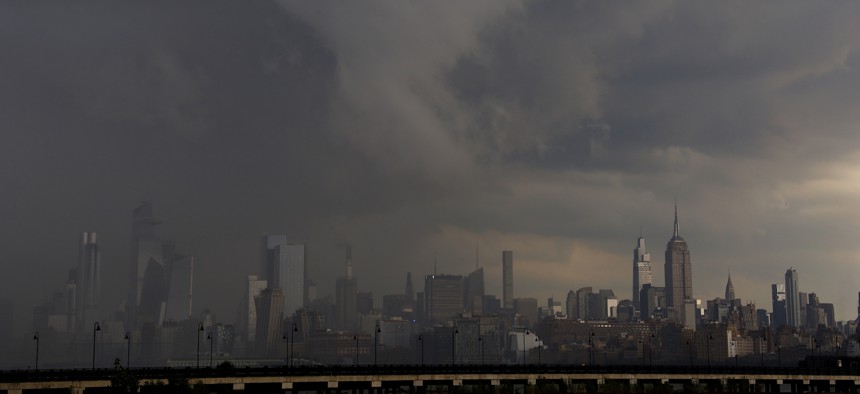New York City
New York City is looking at ‘Band-Aid’ solutions to extreme weather in the near future
The city’s chief climate officer said there’s a long timeline ahead of more extensive infrastructure upgrades.

New York City Chief Climate Officer and Department of Environmental Protection Commissioner Rohit Aggarwala said extreme rainfall over the past year created a “pressure test” for the sewer under Radcliff Avenue in the Bronx, putting a hole in its roof. Gary Hershorn/Getty Images
One month ago, a 20-foot deep sinkhole opened on Radcliff Avenue in the Bronx, swallowing a parked van. No one was hurt in the incident, but water service was temporarily cut for 70 homes in the middle of a heat wave.
At a joint City Council hearing on Tuesday, New York City officials confirmed what some had already assumed: The sinkhole can be attributed to climate change. New York City Chief Climate Officer and Department of Environmental Protection Commissioner Rohit Aggarwala said extreme rainfall over the past year – including from Hurricanes Henri and Ida last summer, as well as heavy rainfall earlier that July week – created a “pressure test” for the sewer under Radcliff Avenue, putting a hole in its roof. Aggarwala, along with colleagues at DEP and the Department of Transportation, testified that the particular method of construction of the sewer in Morris Park, which dates back to 1916, hadn’t been identified elsewhere around the city. “The sinkhole on Radcliffe Avenue would not have been easy to predict given what we know and the tools we currently have,” he said.
But as with other effects of climate change, Aggarwala acknowledged that New York City will be forced to respond to – rather than be able to prevent – the harm to the city’s residents and infrastructure that extreme weather like flooding and heat waves can inflict, while pursuing more permanent upgrades and resiliency measures over the long term. “Realistically, that is what is in our future is a number of Band-Aids to get us through the period of time it'll take to get our infrastructure up to where it needs to be,” Aggarwala said, in particular reference to a city program that provides inflatable dams and sandbags to residents to protect homes in flood-prone areas. About 1,500 people have signed up for that program so far, out of 16,000 residential properties in high-risk areas that the city reached out to. (Some experts have cast doubt on how effective those kinds of steps will be.)
At Tuesday’s joint council hearing, which focused on infrastructure challenges in the face of extreme weather – in particular heat waves, sinkholes and flooding – Aggarwala and other officials said that Mayor Eric Adams’ administration is pursuing multiple levels of resilience, including longer term coastal protection projects and zoning amendments for more sustainable building. Earlier this spring, Adams announced the completion of $50 million worth of sewage and water main upgrades in southeast Queens as part of a yearslong overhaul to address the area’s chronic flooding. But some of those fixes don’t come quick or cheap. “The reality is that heavy construction takes time and public engagement takes time and sound planning takes time,” Aggarwala said. “Even if we operated under pandemic-like emergency procedures, it would still take a long time to change our infrastructure.” Aggarwala added that the city will work to access available state and federal funds to help propel infrastructure upgrades.
In the meantime, Aggarwala pointed to projects including the distribution of inflatable dams, flood sensors, and piloting cloudburst management projects, which involve the design of public spaces like playgrounds for emergency stormwater capture. Cloudbursts describe rapid, sudden, heavy rainfall. “When the sewers are full, when the other green infrastructure is full, during the most extreme rainfall at an Ida kind of level, you would see – if these things are well designed – you would see rainwater being contained in those areas,” he said.
As administration officials outlined steps the city is already taking, some council members noted the urgency of recognizing the disproportionate effects of extreme weather on low-income New Yorkers, and the fact that Black New Yorkers are more likely to die from extreme heat than white New Yorkers. Aggarwala called extreme heat – not water – the deadliest climate hazard to New Yorkers.
Council Member Mercedes Narcisse, who represents neighborhoods in southeastern Brooklyn and sits on the Committee on Transportation and Infrastructure, called for an expansion of cooling centers across the city with a focus on public housing residents. “Why don’t all the NYCHA houses have a cooling system?” Narcisse asked. “That’s something I’ll throw out there because we need that.”

